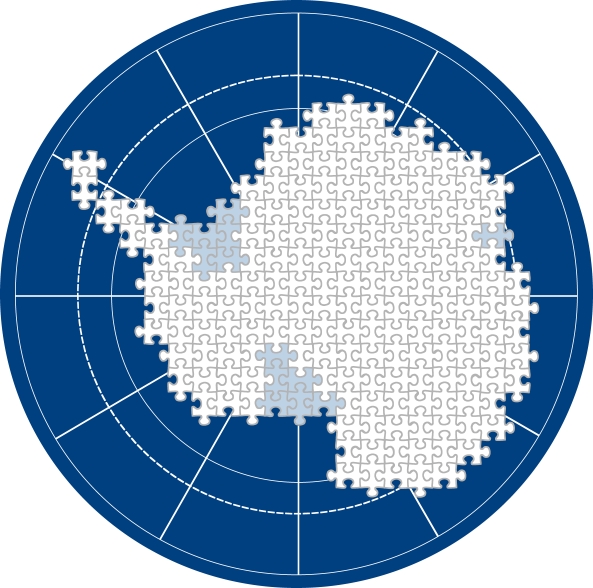Significance for German Polar Research

Just as puzzle pieces interlock and only the correct position of each individual piece of the puzzle forms a complete whole, the logo in the form of the Antarctic continent and the surrounding ocean areas, as shown on the left, symbolises the multidisciplinary approach of the DFG Priority Programme 1158. While Antarctica has long ceased to be a "terra incognita", thanks in part to Germany's contribution to polar research, the white colour symbolises the wish that Antarctica should be used exclusively for peaceful purposes, primarily in the interests of science. Over the past three decades, the coordinated funding of German polar research under the DFG Priority Programme 1158 has ensured that a large number of university and non-university German scientists from all scientific disciplines have been able to make significant contributions to the pressing scientific issues in the polar regions.
The Priority Programme 1158 of the German Research Foundation (DFG) provides both the funding required for research and the framework for coordinated interdisciplinary research and its international integration. This cannot be achieved in the same manner using the DFG funding instrument in a "normal procedure".
Due to the promotion of scientists at universities, specific topics in the polar regions are now an integral part of many courses of study. Thus, a large number of excellently trained and motivated young scientists have become available for the growing tasks in polar research.
As a funding instrument of the German Research Foundation, the Priority Programme "Antarctic Research" has contributed significantly to the fact that, despite the relatively late re-entry into polar research after the Second World War, German science was able to quickly achieve a place in the top group in an international comparison and continues to do so today.
The Role of Polar Regions in the Earth System
The Antarctic plays a special role in the climate and extended Earth system, as it influences the temperature contrast to the tropics – and thus the global atmospheric and oceanic circulation – through its physical and chemical properties, e.g. through the strong reflection of solar radiation on ice and snow surfaces. Examples are the formation of cold air masses over the white, strongly reflecting snow and ice surfaces, the specific chemical changes in the stratosphere in winter, and the formation of oceanic deep and bottom water. Changes in sea ice extent and thickness also have an influence on the interaction of ocean and atmosphere.
Due to their special physical and chemical properties, the polar regions are also characterised by specific flora and fauna that are excellently adapted to these environmental conditions. It reacts very sensitively to climate changes and is therefore an effective climate indicator.
In addition to their importance in the climate system, the polar ice sheets – especially the Antarctic ice sheet – contain a unique climate archive. Its special feature is that only from this archive can information on the composition of the paleo-atmosphere be derived, dating back as far as 800,000 years.
Further information about the dynamics of the ice sheets is only contained in geological archives. These include the sedimentary sequences of marine basins, shallow shelf areas close to the ice rim, and periglacial lakes and coastal waters in ice-free areas. The archived biological and geological information in the marine deep-sea sediments also enables the reconstruction of the paleogeography of sedimentary basins, thus also providing insights from the time of the opening of circumpolar deep water passages, which are essential for the global mass and energy transports.
The importance of the polar regions in the Earth system was also reflected in the third International Polar Year (IPY), which was proclaimed by the International Council for Science and the World Meteorological Organisation for the period from March 2007 to March 2009. The International Polar Year 2007/2008 led to a significant increase in public awareness of polar topics. It also led to an intensification of international polar research and better coordination of research work, for example with the first collection of synoptic, bipolar data sets and observations by pooling international resources. The German Polar Year activities are largely based on the results of the DFG Priority Programme 1158.

